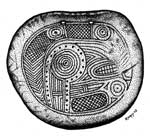VAM galleries including this work:
William S. Webb Museum of Anthropology | Kentucky Past and Present || VAM Home
Fort Ancient Culture
ENGRAVED RATTLESNAKE GORGET, Citico Style, Late Prehistoric Period, 1450-1750 CE
Hardin Village Site, Greenup County, Kentucky
Engraved marine shell (perverse whelk, Busycon perversum); 15.2 cm. X 12.5 cm. X 5 mm.
Catalog Number 15GP22-S29
William S. Webb Museum of Anthropology, University of Kentucky
Kentucky’s native peoples have used marine shells for a variety of decorative and ritual purposes throughout history. The shells would have passed through many hands between the Atlantic or Gulf of Mexico coasts before arriving in Kentucky. Native craftspeople cut gorgets (ornamental collars or protective coverings for the throat) from the walls of whelk shells and drew designs on the shells’ hard, concave inner surfaces, which have a high luster when fresh. They undoubtedly engraved the lines with sharp stone-cutting tools and made small conical pits by drilling into the shell surface. The gorget was worn suspended from a cord around the neck to signify membership in a particular clan group, or dance or medicine society.
Native artisans made two different types of rattlesnake gorgets: one that shows the reptile in a naturalistic manner, and one, like the example shown here, in a more stylized and complex manner in which the design takes precedence over the snake’s anatomical features. Both versions have coiled bodies around the head, which usually faces to the right. The eye is portrayed as a series of concentric circles surrounding a central pit. The mouth is open, with a row of teeth shown in each jaw. Curved feathers or horns on the upper jaw slant back toward the head. Crosshatched lines indicate the scales on the upper surface of the body, which is divided into either three or four segments by chevrons, bars, and concentric circles. The body ends in rattles.
This rattlesnake gorget was recovered from a grave during excavations carried out by the federal government during the Great Depression. To honor Native American requests that photographs of objects recovered with the dead not be shown, a drawing of it is shown instead.
Classroom Ideas
Discussion: What do you think the design on this carving looks like? Would you have guessed that the picture represents a rattlesnake? Native Kentucky peoples used marine shells for a variety of purposes. How do you think native people located in Kentucky would get shells from the East Coast or Gulf of Mexico? Why might a clan or society use a rattlesnake to indicate its identity? What might the symbol of the snake mean?
Activity: Out of respect for Native American peoples’ wish that objects recovered from burial sites not be photographed, this artifact has been shown in the KVAM as a drawing instead. What objects do we bury with our dead today? How would you feel about having your ancestors or loved ones dug up and their belongings analyzed? Is it possible to respect sacred burial customs and to study remains of the deceased for historical purposes? Write a letter to the editor of your local newspaper that reflects your ideas and opinions on the matter.
Links
Learn more about shell ornaments from the Mississippian Moundbuilders and Their Artifacts web site.
[www.mississippian-artifacts.com/html/shellorn.html]
The Metropolitan Museum of Art’s Timeline of Art History includes a rattlesnake gorget.
[metmuseum.org/toah/ho/07/na/ho_1979.206.446.htm]
See more examples of shell gorgets on the Frank H. McClung Museum’s Archaeology and Native Peoples of Tennessee page.
[mcclungmuseum.utk.edu/permex/archaeol/xrm-text.htm]
See the William S. Webb Museum of Anthropology site for lots of teaching resources, including information about time periods, online activities, and lesson plans.
[www.uky.edu/AS/Anthropology/Museum/museum.htm]
Learn more about Kentucky archaeological sites and discoveries at the Kentucky Archaeological Survey web site.
[www.kyheritage.org/kas.htm]
For background on issues surrounding burial sites of native people, read the article on the Native American Graves Protection and Repatriation Act by Renee Kosslak on the University of Dayton School of Law web site, or visit the National Park Service’s NAGPRA information site.
[academic.udayton.edu/race/03justice/NALR007.htm]
[www.cr.nps.gov/nagpra/public/]

